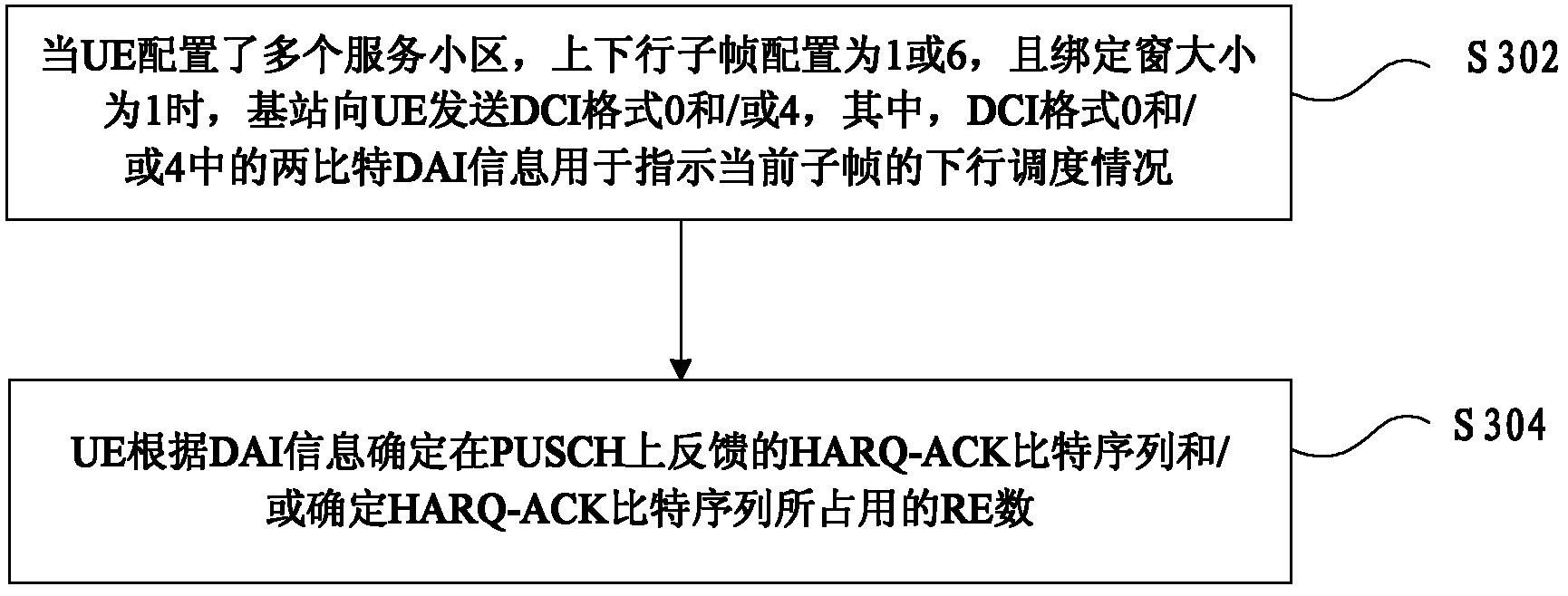Feedback processing method and system for HARQ (Hybrid Automatic Repeat Request) -ACK (Acknowledge Character)
A technology of feedback processing and feedback mode, applied in the field of communication, can solve the problem of large bit sequence size and so on
- Summary
- Abstract
- Description
- Claims
- Application Information
AI Technical Summary
Problems solved by technology
Method used
Image
Examples
Embodiment 1
[0054] The embodiment of the present invention discloses a HARQ-ACK feedback processing method, which can be used in an LTE-A TDD system, image 3 is a flowchart of a HARQ-ACK feedback processing method according to an embodiment of the present invention, such as image 3 As shown, the method includes:
[0055] Step S302, when the UE is configured with multiple serving cells, the uplink and downlink subframe configuration is 1 or 6, and the binding window size is 1, the base station sends DCI format 0 and / or 4 to the UE, wherein DCI format 0 and / or Or the two-bit DAI information in 4 is used to indicate the downlink scheduling situation of the current subframe;
[0056] In step S304, the UE determines the HARQ-ACK bit sequence fed back on the PUSCH and / or determines the number of REs occupied by the HARQ-ACK bit sequence according to the DAI information.
[0057] In this embodiment, the base station notifies the UE of the downlink scheduling situation, and the UE determines ...
Embodiment 2
[0103] This embodiment is applicable to the case where the downlink transmission modes of the primary serving cell and the secondary serving cell are both dual-codeword stream transmission modes. In this case, the following method is used to determine the HARQ-ACK bit sequence fed back on the PUSCH and / or the HARQ-ACK bit sequence fed back on the PUSCH The number of REs occupied by the ACK bit sequence.
[0104] like Figure 4 As shown, when the above two-bit downlink allocation indication information is A, the UE determines that the size of the HARQ-ACK bit sequence fed back on the PUSCH is 4, and the bit sequence is in, corresponding to the HARQ-ACK response message of the primary serving cell, Corresponding to the HARQ-ACK response message of the secondary serving cell; the UE uses O=4 when calculating the number of REs occupied by the HARQ-ACK bit sequence fed back on the PUSCH.
[0105] like Figure 5 As shown, when the above two-bit downlink allocation indication ...
Embodiment 3
[0109] This embodiment is applicable to the case where the downlink transmission modes of the primary serving cell and the secondary serving cell are both single-codeword stream transmission modes. In this case, the following method is used to determine the HARQ-ACK bit sequence fed back on the PUSCH and / or the HARQ-ACK bit sequence fed back on the PUSCH The number of REs occupied by the ACK bit sequence.
[0110] Such as Figure 8 As shown, when the above two-bit downlink allocation indication information is A, the UE determines that the size of the HARQ-ACK bit sequence fed back on the PUSCH is 2, and the bit sequence is in, corresponding to the HARQ-ACK response message of the primary serving cell, Corresponding to the HARQ-ACK response message of the secondary serving cell; the UE uses O=2 when calculating the number of REs occupied by the HARQ-ACK bit sequence fed back on the PUSCH.
[0111] Such as Figure 9 As shown, when the above two-bit downlink allocation ind...
PUM
 Login to View More
Login to View More Abstract
Description
Claims
Application Information
 Login to View More
Login to View More - R&D
- Intellectual Property
- Life Sciences
- Materials
- Tech Scout
- Unparalleled Data Quality
- Higher Quality Content
- 60% Fewer Hallucinations
Browse by: Latest US Patents, China's latest patents, Technical Efficacy Thesaurus, Application Domain, Technology Topic, Popular Technical Reports.
© 2025 PatSnap. All rights reserved.Legal|Privacy policy|Modern Slavery Act Transparency Statement|Sitemap|About US| Contact US: help@patsnap.com



